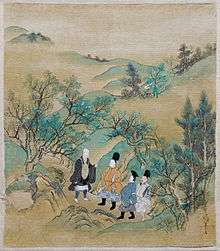The Tales of Ise
The Tales of Ise (伊勢物語 Ise monogatari) is a Japanese uta monogatari, or collection of waka poems and associated narratives, dating from the Heian period. The current version collects 125 sections, with each combining poems and prose, giving a total of 209 poems in most versions.
The exact date of composition and authorship can only be speculated; the identity of the nameless, idealised central character is likewise ambiguous, but suggested to be Ariwara no Narihira (825–880).[1] Thirty of the poems from The Tales of Ise appear in the Kokin Wakashū (905), with similar headnotes, all attributed to Narihira. The combination of these poems, and the similarity of some events in the tales to Narihira's life, have led to the additional suggestion that Narihira actually composed the work; however, the inclusion of material and events dating after 880 suggests otherwise.
Title
The late-eleventh century[2] work known as The Tale of Sagoromo refers to Ise by the variant name Zaigo Chūjō no Nikki (在五中将の日記, "Narihira's diary").[3]
Authorship
Theories vary as to the identity of the author, with some suggesting Ki no Tsurayuki. Others have, based on the title of the work, guessed that it may have been composed by the poet Ise, but this is generally taken as unlikely, as none of the other known works of this period use the names of their authors as their principal titles.
Origin and structure

The Tales of Ise may have developed from specific poetry sets, but with accretions of later narratives, intending to ground the poems in a specific historical time and place, and develop an overall theme. Kashu, private or individual poetry collections, provide a journal of selected works, with headnotes covering the circumstances of the composition; it is possible Narihira may have created such a collection, which was subsequently adapted to portray an idealised vision of the poet. Volume 16 of the Man'yōshū also has a large selection of poems preceded by narratives in classical Chinese, bearing a similarity to the narrative style of the Tales of Ise.
The narrative makes little attempt to link the sections, but introduces or provides a scene for the composition of the poem. A rough chronology of the central character's life is established through the sections, from the 'young man who came of age' in section 1, through numerous adventures and loves, to the man who fell gravely ill and 'knew in his heart that he was to die', in section 125. This neither produces a traditional biography, nor even a traditional plot, as seen from a Western perspective.
At least four theories for the title of the work have been proposed by commentators from the Kamakura period onwards: the work was written by Lady Ise and named after her; the title followed from section 69, as the central character visits the Priestess at Ise Grand Shrine; in the Nihon Shoki, the character for I reads as woman, and Se reads as man, leading to the text embodying the theme of union; the author deliberately distorted events, places, people, and times, embodying the phrase Ise ya Hyuga or 'topsy-turvy'.[4]
Thematically, The Tales of Ise embodies the courtly miyabi aesthetic, prevalent among the surviving works produced by and for the culture elite of the Heian period, such as the more well-known The Tale of Genji. The poems themselves explore nature, the court society, culture, and love and relationships. A highlight can be shown from the interlude in section 9, as the central character rests beside the yatsuhashi or eight bridges in the famous iris marshes of Mikawa province. The poem he composes combines these themes: the sense of loss at leaving the capital, viewed as the only place of society and culture; longing for lost loves; and the beauty of the natural environment.
- から衣 きつゝなれにし つましあれば はるばるきぬる たびをしぞ思
- Karagoromo / kitsutsu narenishi / tsuma shi areba / harubaru kinuru / tabi o shi zo omou
- I have a beloved wife / familiar as the skirt / of a well-worn robe / and so this distant journeying / fills my heart with grief[5]
See also
References
Bibliography
- Richard Bowring, 'The Ise monogatari: A short cultural history', Harvard Journal of Asiatic Studies, vol. 52, no. 2 (December 1992), pp. 401–480.
- H. Jay Harris (translator), The Tales of Ise, North Clarendon: Tuttle Publishing, 1972. ISBN 0-8048-3338-9.
- Keene, Donald (1999). A History of Japanese Literature, Vol. 1: Seeds in the Heart — Japanese Literature from Earliest Times to the Late Sixteenth Century. New York: Columbia University Press. ISBN 978-0-231-11441-7.
- Helen Craig McCullough (translator), Tales of Ise: Lyrical Episodes from Tenth-Century Japan, Stanford: Stanford University Press, 1968. ISBN 0-8047-0653-0.
External links
| Wikimedia Commons has media related to The Tales of Ise. |
- A transcription of the Tales of Ise from the University of Virginia Library Electronic Text Center.
- A lacquered writing box by Ogata Korin illustrating the eight bridges section of the tales; the box is a National Treasure of Japan, held in the Tokyo National Museum.
- Scenes from the Tales of Ise on Edo period screens from The Mary and Jackson Burke Foundation.
- An illustrated wood-block printed version of the Tales of Ise held in the New York Public Library.